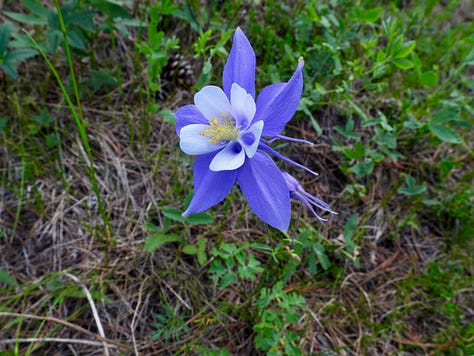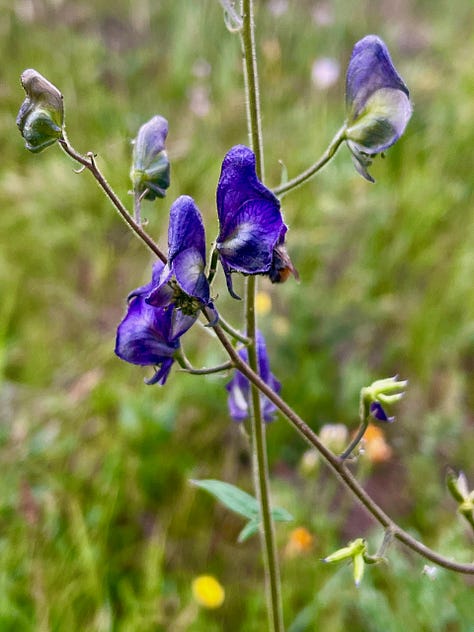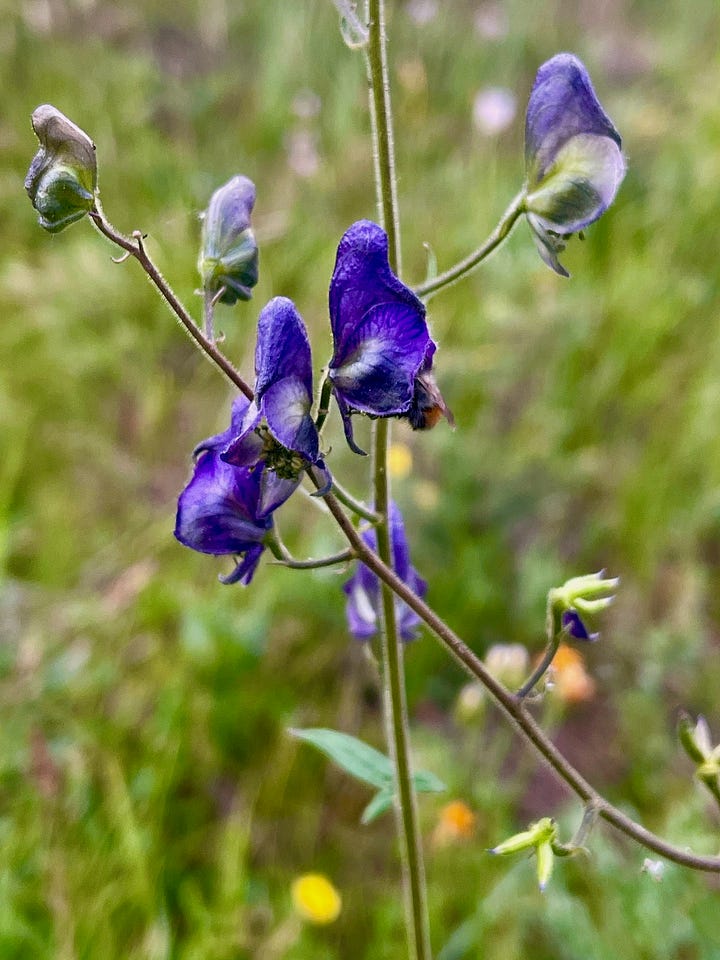Monkshood
Lovely to look at. And, yes, take a photo. But, best not to touch it, or you might not grow old-OH!
Time for a republish of this post as Monkshood is blooming now. Previously published Summer 2023.
Colorado’s soggy spring has produced a banner wildflower season this year. All hiking trails, peak ascents, and our own mountain properties are carpeted with a wide variety of colors. Everything from the tiny white Northern Bedstraw to the showy red, Paint Brush, and the grand Colorado State Flower, the Columbine.



Years ago, I recall being at the Maroon Bells near Aspen in a similar boom of wildflowers and noticed an out-of-state tourist load her arms and the arms of her daughter up with a variety of blooms. The stems were cut, the damage was done, her beautiful bouquet would hardly last the day. Thankfully, a forest ranger soon spoke to her and stopped her flower gathering. Not only was she in violation of Colorado law that protects our wildflowers, especially the Columbine, but she stopped those blooms from finishing their cycles of going to seed and forming next season’s blooms. Her biggest mistake, though, might have been the potential handling of a beautiful purple flower that is one of the most poisonous known to man.



Monkshood, Wolfsbane, Thor’s Helmet, Queen of Poisons, Aconite, and Devil’s Helmet are some of the folk names for Aconitum columbianum. The bell-shaped petals resemble a monk’s cowl, an executioner’s hood, or a helmet. Found around the Northern Hemisphere, near damp, boggy areas, this plant has been used for millennia to poison arrows, execute criminals, poison wolves in Europe - hence, Wolfsbane, and even take out the Roman Emperor, Claudius. It’s the stuff of intrigue and murder mystery books. All parts of the plant are poisonous, from the flower to the tuber root system. Just touching the plant can introduce the toxins through your skin and ingesting it will put you in the hospital for a long stay if you survive it.
What does Monkshood do to you? Containing cardio-active alkaloids, the effects of the toxins will mess with your digestive system first in vomiting, diarrhea, abdominal pain, chest pain, and dizziness as it works in you moving toward affecting your heart, slowing or accelerating the heart rate, and nervous system. Not getting medical help in time can be deadly. What an awful way to go.
You might tell me that Monkshood is used in traditional Chinese and Indian medicines. True, these are minute doses in highly controlled preparations sometimes used to reduce a fever or with some neurologic conditions. But, don’t try this in your own kitchen and reach for the acetaminophen for that fever instead.


While deer and other mammals know to steer clear of Monkshood, it is a safe place for many caterpillars, moths, butterflies, bumblebees, and other pollinators. In fact, it’s a primary food for Old World Bumblebees. These bigger bees have the strength to push open the petals to the nectar inside. Amazingly, the alkaloids in the nectar are a deterrent to non-pollinating insects. Keeping the pollinators fed truly, literally, keeps the world humming. Monkshood holds its own in the ecology of the meadows it grows in. Just remember for YOU to stay away when you see that lovely executioner’s hood flower.
Sources:
- All photo credits are copyright The Abert Essays unless otherwise noted.
- https://www.fs.usda.gov/wildflowers/ethics/
- https://wellfieldgardens.org/2020/10/17/monkshood-the-spookiest-of-all/
- https://www.webmd.com/first-aid/monkshood-poisoning Some scary stories here.
- https://en.wikipedia.org/wiki/Aconitum
You can find The Abert Essays on my social media sites also:





Wow, I learned something very valuable today, thanks!
Monkshood is so beautiful. Wonderful and informative post.